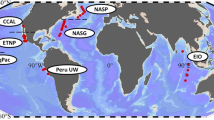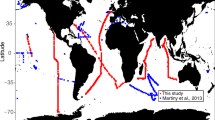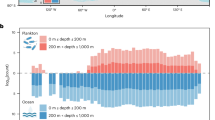Abstract
The elemental content of microbial communities is dependent upon the physiology of constituent populations, yet ecological stoichiometry has made slow progress toward identifying predictors of how species and strains change the elemental content of their biomass in response to the stoichiometry of elements in resources. We asked whether the elemental content of aquatic bacteria, especially flexibility in elemental content, could be predicted by their phylogeny, maximum growth rate or lake productivity. We examined 137 isolates using chemostats and found that strains differed substantially in how the carbon:nitrogen:phosphorus ratios (C:N:P) in their biomass responded to P-sufficient and P-limiting conditions. The median strain increased its biomass C:N:P from 68:14:1 to 164:25:1 under P limitation. Patterns in elemental content and ratios were partly explained by phylogeny, yet flexibility in elemental content showed no phylogenetic signal. The growth rate hypothesis predicts that P content is positively related to growth rate, but we found weak correlation between maximum growth rate and P content among the strains. Overall, isolates from highly productive lakes had higher maximum growth rates and less flexible biomass N:P than isolates from unproductive lakes. These results show that bacteria present within lake communities exhibit diverse strategies for responding to elemental imbalance.
Similar content being viewed by others
Log in or create a free account to read this content
Gain free access to this article, as well as selected content from this journal and more on nature.com
or
References
American Public Health Association. (1995) Standard Methods for the Examination of Water and Wastewater: Including Bottom Sediments and Sludges, 20th edn. American Public Health Association: New York.
Blomberg SP, Garland T, Ives AR . (2003). Testing for phylogenetic signal in comparative data: behavioral traits are more labile. Evolution 57: 717–745.
Bonachela JA, Klausmeier CA, Edwards KF, Litchman E, Levin SA . (2016). The role of phytoplankton diversity in the emergent oceanic stoichiometry. J Plankton Res 38: 1021–1035.
Chrzanowski TH, Kyle M . (1996). Ratios of carbon, nitrogen and phosphorus in pseudomonas fluorescens as a model for bacterial element ratios and nutrient regeneration. Aquat Microb Ecol 10: 115–122.
Colwell RR, Grimes DJ . (2000) Nonculturable Microorganisms in the Environment. ASM press: Washington, DC.
Davelaar D . (1993). Ecological significance of bacterial polyphosphate metabolism in sediments. Hydrobiologia 253: 179–192.
Droop MR . (1973). Nutrient limitation in osmotrophic protista. Am Zool 13: 209–214.
Elser JJ, Sterner RW, Gorokhova E, Fagan WF, Markow TA, Cotner JB et al. (2000). Biological stoichiometry from genes to ecosystems. Ecol Lett 3: 540–550.
Elser JJ, Acharya K, Kyle M, Cotner J, Makino W, Markow T et al. (2003). Growth rate-stoichiometry couplings in diverse biota. Ecol Lett 6: 936–943.
Freckleton RP, Harvey PH, Pagel M . (2002). Phylogenetic analysis and comparative data: a test and review of evidence. Am Nat 160: 712–726.
Galbraith ED, Martiny AC . (2015). A simple nutrient-dependence mechanism for predicting the stoichiometry of marine ecosystems. Proc Natl Acad Sci USA 112: 8199–8204.
Garcia NS, Bonachela JA, Martiny AC . (2016). Interactions between growth-dependent changes in cell size, nutrient supply and cellular elemental stoichiometry of marine synechococcus. ISME J 10: 2715–2724.
Garland T, Dickerman AW, Janis CM, Jones JA . (1993). Phylogenetic analysis of covariance by computer simulation. Syst Biol 42: 265–292.
Ghosh S, LaPara TM . (2007). The effects of subtherapeutic antibiotic use in farm animals on the proliferation and persistence of antibiotic resistance among soil bacteria. ISME Jl 1: 191–203.
Godwin CM, Cotner JB . (2014). Carbon:phosphorus homeostasis of aquatic bacterial assemblages is mediated by shifts in assemblage composition. Aquat Microb Ecol 73: 245–258.
Godwin CM, Cotner JB . (2015a). Aquatic heterotrophic bacteria have highly flexible phosphorus content and biomass stoichiometry. ISME J 9: 2324–2327.
Godwin CM, Cotner JB . (2015b). Stoichiometric flexibility in diverse aquatic heterotrophic bacteria is coupled to differences in cellular phosphorus quotas. Front Microbiol 6: 159.
Godwin CM, Whitaker EA, Cotner JB . (2017). Growth rate and resource imbalance interactively control biomass stoichiometry and elemental quotas of aquatic bacteria. Ecology 98: 820–829.
Goldman JC, McCarthy JJ, Peavey DG . (1979). Growth-rate influence on the chemical composition of phytoplankton in oceanic waters. Nature 279: 210–215.
Goldman JC, Caron DA, Dennett MR . (1987). Regulation of gross growth efficiency and ammonium regeneration in bacteria by substrate C: N ratio. Limnol Oceanogr 32: 1239–1252.
Hendrixson HA, Sterner RW, Kay AD . (2007). Elemental stoichiometry of freshwater fishes in relation to phylogeny, allometry and ecology. J Fish Biol 70: 121–140.
Hillebrand H, Steinert G, Boersma M, Malzahn A, Léo Meunier C, Plum C et al. (2013). Goldman revisited: faster growing phytoplankton has lower n:P and lower stoichiometric flexibility. Limnol Oceanogr 58: 2076–2088.
Jeyasingh PD, Weider LJ, Sterner RW . (2009). Genetically-based trade-offs in response to stoichiometric food quality influence competition in a keystone aquatic herbivore. Ecol Lett 12: 1229–1237.
Jeyasingh PD, Goos JM, Thompson SK, Godwin CM, Cotner JB . (2017). Ecological stoichiometry beyond redfield: an ionomic perspective on elemental homeostasis. Front Microbiol 8: 722.
Lebaron P, Servais P, Agogue H, Courties C, Joux F . (2001). Does the high nucleic acid content of individual bacterial cells allow us to discriminate between active cells and inactive cells in aquatic systems? Appl Environ Microbiol 67: 1775–1782.
Livermore JA, Emrich SJ, Tan J, Jones SE . (2014). Freshwater bacterial lifestyles inferred from comparative genomics. Environ Microbiol 16: 746–758.
Lopez JS, Garcia NS, Talmy D, Martiny AC . (2016). Diel variability in the elemental composition of the marine cyanobacterium synechococcus. J Plankton Res 38: 1052–1061.
Makino W, Cotner JB, Sterner RW, Elser JJ . (2003). Are bacteria more like plants or animals? Growth rate and resource dependence of bacterial C : N : P stoichiometry. Funct Ecol 17: 121–130.
Makino W, Cotner JB . (2004). Elemental stoichiometry of a heterotrophic bacterial community in a freshwater lake: implications for growth- and resource-dependent variations. Aquat Microb Ecol 34: 33–41.
Martiny AC, Ma L, Mouginot C, Chandler JW, Zinser ER . (2016). Interactions between thermal acclimation, growth rate, and phylogeny influence prochlorococcus elemental stoichiometry. PLoS One 11: e0168291.
Martiny JB, Jones SE, Lennon JT, Martiny AC . (2015). Microbiomes in light of traits: a phylogenetic perspective. Science 350: aac9323.
Merchant SS, Helmann JD . (2012). Elemental economy: microbial strategies for optimizing growth in the face of nutrient limitation. Adv Microb Physiol 60: 91.
Mouginot C, Kawamura R, Matulich KL, Berlemont R, Allison SD, Amend AS et al. (2014). Elemental stoichiometry of fungi and bacteria strains from grassland leaf litter. Soil Biol Biochem 76: 278–285.
Münkemüller T, Lavergne S, Bzeznik B, Dray S, Jombart T, Schiffers K et al. (2012). How to measure and test phylogenetic signal. Methods Ecol Evol 3: 743–756.
Narwani A, Alexandrou MA, Herrin J, Vouaux A, Zhou C, Oakley TH et al. (2015). Common ancestry is a poor predictor of competitive traits in freshwater green algae. PLoS One 10: e0137085.
Newton RJ, Jones SE, Helmus MR, McMahon KD . (2007). Phylogenetic ecology of the freshwater actinobacteria aci lineage. Appl Environ Microbiol 73: 7169–7176.
Nielsen SL, Enriquez S, Duarte CM, SandJensen K . (1996). Scaling maximum growth rates across photosynthetic organisms. Funct Ecol 10: 167–175.
Pagel M . (1999). Inferring the historical patterns of biological evolution. Nature 401: 877–884.
Persson J, Fink P, Goto A, Hood JM, Jonas J, Kato S . (2010). To be or not to be what you eat: regulation of stoichiometric homeostasis among autotrophs and heterotrophs. Oikos 119: 741–751.
Phillips KN, Godwin CM, Cotner JB . (2017). The effects of nutrient imbalances and temperature on the biomass stoichiometry of freshwater bacteria. Front Microbiol 8: 1692.
Quigg A, Finkel ZV, Irwin AJ, Rosenthal Y, Ho T-Y, Reinfelder JR et al. (2003). The evolutionary inheritance of elemental stoichiometry in marine phytoplankton. Nature 425: 291–294.
Redfield AC . (1958). The biological control of chemical factors in the environment. Am Scientist 46: 205–221.
Revell LJ . (2012). Phytools: an R package for phylogenetic comparative biology (and other things). Methods Ecol Evo 3: 217–223.
Rhee G-Y . (1973). A continuous culture study of phosphate uptake, growth rate and polyphosphate in scenedesmus sp. J Phycol 9: 95–506.
Rhee G-Y . (1978). Effects of N:P atomic ratios and nitrate limitation on algal growth, cell composition, and nitrate uptake. Limnol Oceanogr 23: 10–25.
Sardans J, Rivas-Ubach A, Peñuelas J . (2011). Factors affecting nutrient concentration and stoichiometry of forest trees in catalonia (ne spain). Forest Ecol Manage 262: 2024–2034.
Scott JT, Cotner JB, Lapara TM . (2012). Variable stoichiometry and homeostatic regulation of bacterial biomass elemental composition. Front Microbiol 3: 42.
Sterner RW, Elser JJ . (2002) Ecological Stoichiometry: The Biology of Elements from Molecules to the Biosphere. Princeton University Press: Princeton, NJ, USA.
Tamura K, Stecher G, Peterson D, Filipski A, Kumar S . (2013). Mega6: molecular evolutionary genetics analysis version 6.0. Mol Biol Evol 30: 2725–2729.
Tanner R . (2002) Cultivation of bacteria and fungi In: Hurst C, Knudsen G, McInerney M, Stetzenbach L, Walter M (eds) Manual of Environmental Microbiology, 2nd edn 2nd edn.ASM Press: Washington, DC.
Thingstad TF, Øvreas L, Egge JK, Løvdal T, Heldal M . (2005). Use of non-limiting substrates to increase size; a generic strategy to simultaneously optimize uptake and minimize predation in pelagic osmotrophs? Ecol Lett 8: 675–682.
Velji MI, Albright LJ . (1993) Improved sample preparation for enumeration of aggregated aquatic substrate bacteria. In: Kemp PF, Sherr BF, Sherr EB, Cole JJ (eds). Handbook of Methods in Aquatic Microbial ecology. Lewis Publishers: Boca Raton, pp 139–142.
Warton DI, Wright IJ, Falster DS, Westoby M . (2006). Bivariate line-fitting methods for allometry. Biol Rev 81: 259–291.
Zimmerman AE, Allison SD, Martiny AC . (2014). Phylogenetic constraints on elemental stoichiometry and resource allocation in heterotrophic marine bacteria. Environ Microbiol 16: 1398–1410.
Acknowledgements
This work was supported by NSF-IOS award 1257571 to JBC. Andrea Little, Emily Whitaker, Chandra Dahlke, Maddy Jackson and Cole Spencer helped to run the experiment.
Author information
Authors and Affiliations
Corresponding author
Ethics declarations
Competing interests
The authors declare no conflict of interest.
Additional information
Supplementary Information accompanies this paper on The ISME Journal website
Supplementary information
Rights and permissions
About this article
Cite this article
Godwin, C., Cotner, J. What intrinsic and extrinsic factors explain the stoichiometric diversity of aquatic heterotrophic bacteria?. ISME J 12, 598–609 (2018). https://doi.org/10.1038/ismej.2017.195
Received:
Revised:
Accepted:
Published:
Issue date:
DOI: https://doi.org/10.1038/ismej.2017.195
This article is cited by
-
Glacier runoff impacts the stoichiometry of riverine nutrient export from coastal Alaskan catchments
Communications Earth & Environment (2025)
-
Stream C to N to P ratios aligned with microbial needs enhance biofilm nitrate uptake and subsequent nitrogen loss
Biogeochemistry (2025)
-
Irradiance and biofilm age control daytime and nighttime macronutrient cycling in stream mesocosms
Biogeochemistry (2025)
-
Consistent stoichiometric long-term relationships between nutrients and chlorophyll-a across shallow lakes
Nature Communications (2024)
-
Disentangling effects of multiple agricultural stressors on benthic and hyporheic nitrate uptake
Biogeochemistry (2024)



